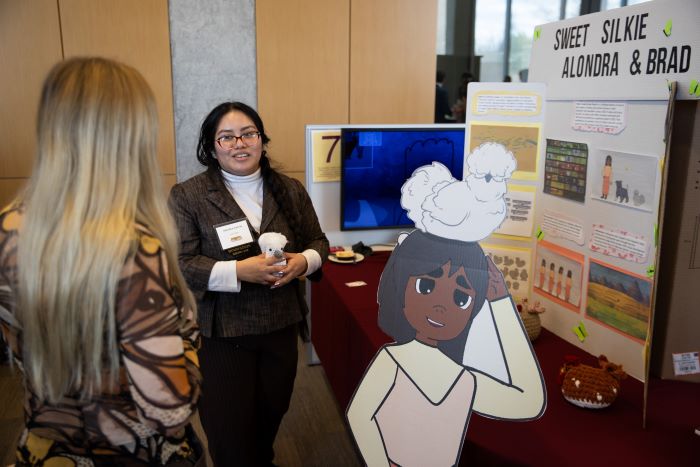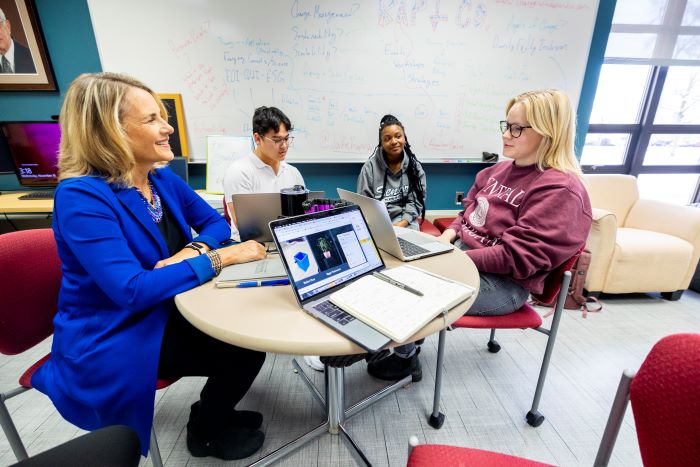
Start up
Passion. Potential. Pitches. Don't miss any of the 2025 New Venture Challenge excitement.
Tune in Friday, April 11 at 1 p.m. for great ideas and fierce competition. Then, join the judges, mentors, spectators and teams as they see who is going home with thousands of dollars in venture financing. The awards broadcast begins at 6:30 p.m. and one team will walk away as the overall best venture.
Central Michigan University’s College of Business Administration is the home of the Isabella Bank Institute for Entrepreneurship and the first Department of Entrepreneurship in the state of Michigan. We are a student-centric hub where experiential, curricular, and external entrepreneurial opportunities intersect.
Our mission is to maximize student success by fostering a campus-wide entrepreneurial mindset that promotes inter-disciplinary collaboration and the creation of new ventures.
We aim to create innovative programming, boost cross-campus and ecosystem collaboration and provide a comprehensive mentoring program.
Our institute provides extracurricular opportunities and is open to all undergraduate and graduate CMU students.
Are you interested in becoming an entrepreneur?
Every journey is unique. Explore the opportunities that interest you.
When historic floods breached two mid-Michigan dams in May, emptying Wixom Lake and Sanford Lake, Daelyn Woolnough saw a consequence few others might have considered: the loss of water-filtering mussels — some rare — by the tens of thousands.
![Mug-[Woolnough]](/images/default-source/presidents-division/university-communications/news/2021/mug--woolnough-81f69112-668f-41cc-81da-0ff7a7fe71ef.jpg?Status=Master&sfvrsn=1801452_3) Woolnough, a Central Michigan University research associate professor in Biology, is a member of the Institute for Great Lakes Research in the College of Science and Engineering. She's studied the influence of contaminants on native mussels and the host fish that disperse their larvae, the effects of dams and dam removals on mollusks in Great Lakes watersheds, and aquatic habitats in urban and agricultural landscapes.
Woolnough, a Central Michigan University research associate professor in Biology, is a member of the Institute for Great Lakes Research in the College of Science and Engineering. She's studied the influence of contaminants on native mussels and the host fish that disperse their larvae, the effects of dams and dam removals on mollusks in Great Lakes watersheds, and aquatic habitats in urban and agricultural landscapes.
Now, at the request of the Michigan Department of Natural Resources, Woolnough and a team of CMU graduate and doctoral students are working at the Tittabawassee and Tobacco rivers after the failure of the Edenville and Sanford dams. They're assessing the impact of the river's drainage on the native freshwater mussel population, joined by members of the MDNR and the Michigan Department of Environment, Great Lakes, and Energy.
Here's Woolnough's perspective as a CMU expert on freshwater mussels.
A: Freshwater mussels are important to our rivers because they take chemicals out of the water as they filter it for food. They actually conduct a free ecosystem service for us that works better than a wastewater treatment plant. Mussels also add stability to the bottom of lakes and rivers to prevent erosion. Also, among the mussels in these rivers are the federally endangered snuffbox mussels and up to five other state-endangered or special-concern species.
A: Mussels cannot move fast and, unlike fish, cannot move with the moving water. Therefore, any mussels that were on the bottom of the lakes, and not in the main river channel that runs through the middle of the lakes, remain on top of soil in dewatered areas and are dead or dying. The numbers are likely to be in the tens of thousands.
A: Generally, live mussels found in a situation like this would be returned to the closest body of water with appropriate habitat for their survival. Sometimes, because we have the facilities at CMU in the Biosciences Vivarium — and if the mussels are rare, as some are in this case — we can house them in quarantine until colleagues in state or federal agencies decide, in conjunction with CMU's guidance, when and where to return them.
A: Native freshwater mussels can live for more than 75 years. Mussels in areas like Sanford or Wixom lakes can live 15-30 years. In an event like this, the major problem is that you lose huge numbers of entire generations. And even with hatchery services — like what we can do at CMU — young mussels are pretty difficult to reproduce. They take two to four years before they become reproductively viable. So, even with repopulation from the mussels still in the adjacent rivers or using hatchery-reared mussels, it will take five to 10 years to repopulate the lakes if the dams are fixed.

Explore special opportunities to learn new skills and travel the world.

Present your venture and win BIG at the New Venture Challenge.

Boost your entrepreneurial skills through our workshops, mentor meetups and pitch competitions.

Learn about the entrepreneurship makerspace on campus in Grawn Hall.

Present a 2-minute pitch at the Make-A-Pitch Competition and you could win prizes and bragging rights!

Connect with mentors and faculty who are here to support the next generation of CMU entrepreneurs.

Are you a CMU alum looking to support CMU student entrepreneurs? Learn how you can support or donate to the Entrepreneurship Institute.